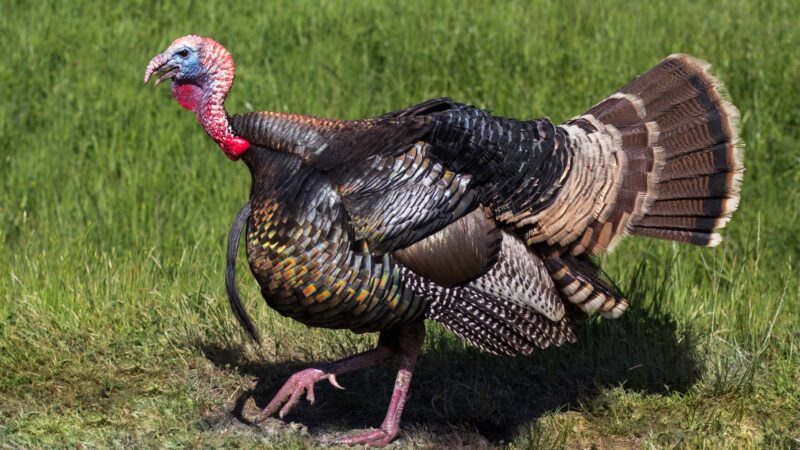Wild turkeys can fly. Despite their large size, these agile birds are capable of flying at speeds of up to 55 miles per hour for short distances, typically a mile or less. Domesticated turkeys, however, are generally unable to fly due to selective breeding for size and weight.
In this article, we’ll explore the fascinating world of wild turkeys and their flying abilities. We’ll discuss their speed, distances, and heights they can achieve, as well as how domestic turkeys compare.
We’ll also delve into other questions related to turkey flight, such as their ability to cross fences or roost in trees, and share some tips for managing flying turkeys on your property. So, let’s take off on this wild turkey adventure!
Table of Contents
Do Turkeys Have Wings?

Turkeys have wings, and they play a crucial role in their ability to fly. Both wild and domestic turkeys have large, strong wings that can span over four feet when fully extended. In wild turkeys, these wings provide the power and lift needed for short, fast flights, while in domestic turkeys, they are typically underdeveloped and inadequate for sustained flight due to selective breeding for size.
How Fast Can Wild Turkeys Fly?
How Far Can Wild Turkeys Fly?
Wild turkeys can fly at impressive speeds of up to 55 miles per hour. However, they are not long-distance flyers. They usually cover a distance of one mile or less during a single flight, often using this ability to escape predators or navigate their environment.
How High Can Turkeys Fly?
Wild turkeys are capable of flying at altitudes of up to 200 feet. They typically use this ability to roost in trees at night, which offers protection from ground-dwelling predators.
Can Domestic Turkeys Fly?

Domestic turkeys are generally unable to fly. Selective breeding for larger size and increased weight has resulted in underdeveloped wings and muscles, which makes flight nearly impossible for most domestic turkey breeds.
Will Turkeys Cross a Fence?
Can Wild Turkeys Fly over Fences?
Wild turkeys are adept at flying over fences when necessary. They can easily clear fences of varying heights to access food or escape predators. This ability makes them highly adaptable to different environments and situations.
Can Turkeys Fly up into Trees?

Wild turkeys can and do fly up into trees. They usually roost in trees at night to protect themselves from predators. This behavior is another advantage of their ability to fly, as it allows them to find safety and shelter in higher places.
Can Male Turkeys Fly?

Male turkeys, also known as toms or gobblers, can indeed fly. Although they are larger and heavier than females, they still possess the necessary strength and wing development to take flight when needed, albeit for shorter distances than their female counterparts.
When Can Baby Turkeys Fly?
Baby turkeys, called poults, begin developing their flight abilities around two weeks of age. By three to four weeks old, they can fly well enough to reach tree branches for roosting.
How Do I Stop My Turkey from Flying?
If you need to prevent your domestic turkey from flying, you can consider trimming its primary flight feathers, also known as wing clipping. This is a painless and temporary method that inhibits their ability to fly without causing harm.
How Do You Cut Turkey Wings So They Can’t Fly? | A Step by Step Guide
- Hold the turkey securely: Enlist the help of another person to hold the turkey, or wrap it in a towel to keep it calm and still.
- Extend the wing: Gently extend one wing to expose the primary flight feathers.
- Identify the primary flight feathers: Locate the long, primary flight feathers that are responsible for lift and flight. There are typically 10 primary flight feathers on each wing.
- Trim the feathers: Using sharp scissors or shears, carefully trim the primary flight feathers at the level of the secondary flight feathers, leaving the secondary feathers intact. Be cautious not to cut into the feather shaft or the bird’s skin.
- Repeat on the other wing: Perform the same process on the other wing to ensure the bird remains balanced.
- Monitor the bird: Keep an eye on your turkey to ensure it is not experiencing any discomfort or distress after the procedure. Remember that feathers grow back, so you may need to repeat the process as needed.
- Please note that this method should not be used on wild turkeys, as it can impede their ability to escape predators and survive in their natural environment.
Do Turkeys Migrate?

Unlike some bird species, turkeys do not undergo long-distance migration. Instead, they tend to have a home range, which is an area where they live, forage, and breed throughout the year. Seasonal movements may occur within this home range, but they do not undertake significant migratory journeys.
List of Sources
Moorman, C., Megalos, M., Bowen, L. (2019). Wild Turkey. N.C. Cooperative Extension.
Rio Grande Wild Turkey. Texas A&M AgriLife Extension Wildlife & Fisheries.
Morse, S. Wild Facts About Wild Turkeys. U.S. Fish & Wildlife Service.
